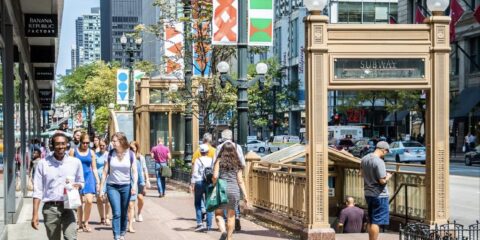Nearly five years after the onset of the pandemic, 1 in 3 storefronts remain vacant in the Loop as retail vacancy held steady in 2024. The Loop retail vacancy rate was 29.78% in 2024, down slightly from 30.13% in 2023, according to a report from Chicago-based retail brokerage Stone Real Estate. Though the rate remaining flat is a reprieve from its steady rise since 2021 (the brokerage didn’t calculate a rate in 2020), it’s still about double the pre-pandemic vacancy rate of 14.92% in 2019. Since the COVID-19 shutdown in March 2020, retailers have vacated 222 storefronts totaling 660,000 square feet of retail space, according to Stone Real Estate’s analysis. Of the district’s 1,307 storefronts, 449 are empty, adding up to more than 1.3 million square feet of vacant space. As remote work persisted, retailers that relied on steady traffic from office workers shrunk their footprints or left entirely. Fast-casual restaurants vacated 153,000 square feet of retail space, and LaSalle and State streets saw the departure of numerous apparel retailers. While foot traffic is recovering, Stone Principal John Vance said he doesn’t know if the Loop’s retail vacancy rate has hit bottom yet. But the market got some good news with Gap Factory’s recent lease at 17 N. State St., and developments that would give the corridor a much-needed boost are taking steps forward, he said.
Google’s massive overhaul of the James R. Thompson Center has the potential to energize the Loop and attract new employers, while plans to transform office buildings on and near LaSalle Street into apartments are moving forward, which would bring more density and around-the-clock activity to downtown. “Retailers go where the people are,” Vance said. Once completed, those projects would mean more foot traffic and density for the LaSalle-Wacker corridor, which had the highest vacancy rate of the Loop submarkets at approximately 36.2%, staying flat from 2023. Vacancy in the central Loop submarket, which includes State Street, declined slightly to 26.06% from 26.59%. The Gap Factory lease, which is for the space where Express closed its store, prevented the vacancy rate from increasing and solidified the corridor as a destination for value-oriented apparel concepts. “That hole in the market is going to be filled, and so when the pedestrian is on the street, at least that block of State Street, there’s no vacancy, there’s an occupant of the storefront. . . .It looks better and it feels better, and then it will hopefully create this foundation on the street where retailers can follow suit,” Vance said. “I think we’ll see these green shoots start to grow.” The Michigan Avenue corridor, which covers the stretch of the street bounded by the Chicago River to the north and Ida B. Wells Drive to the south, also saw a slight drop in vacancy, to 27.78% from 28.18%. The corridor got two new cafes, Te’amo boba and dessert bar at 36 S. Michigan Ave. and Sugary Chicago, a brunch and dessert spot, at 108 S. Michigan Ave., which mainly cater to tourists visiting the Art Institute of Chicago. Two fast-casual restaurants are planning locations at 20 N. Michigan Ave. across from Millennium Park, French cafe Lea and Korean-inspired SeoulSpice, which will rely on a mix of tourists and office workers. In the West Loop submarket, bounded by the Chicago River to the East, I-90/94 to the west, the south side of Lake Street to the north and Ida B. Wells Drive to the south, the vacancy rate increased to 28.13% from 25.04%. Vance attributed that uptick to office users that occupied ground-floor retail spaces vacating them due to remote work .

